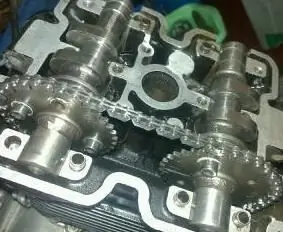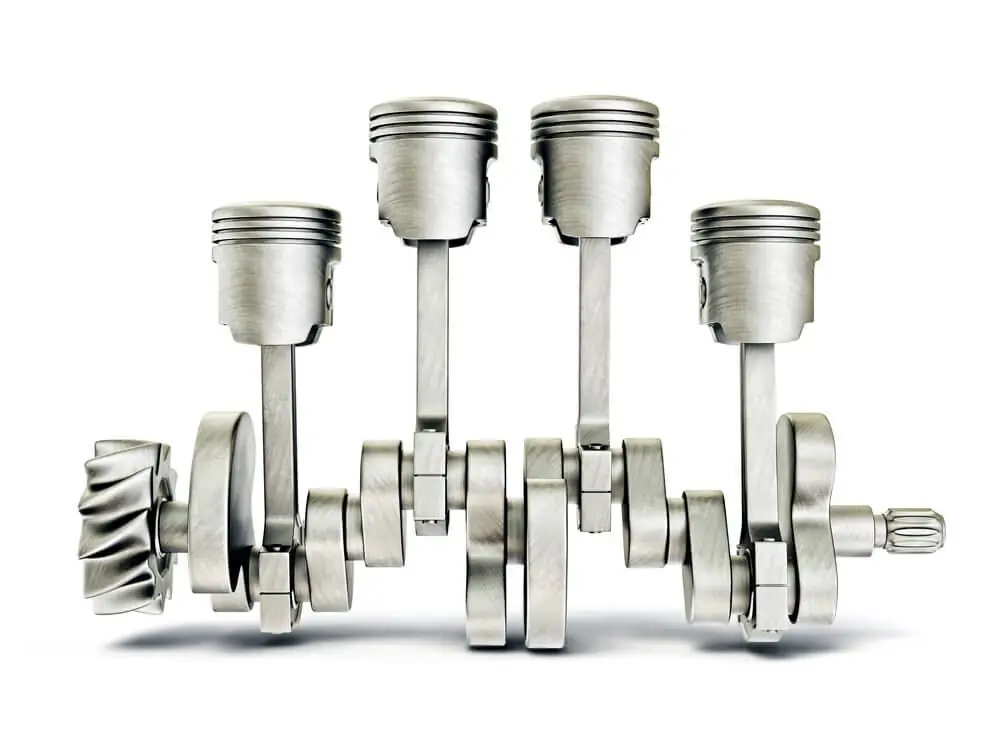2025 Author: Erin Ralphs | [email protected]. Last modified: 2025-01-22 21:14:11
Despite the growing popularity of electric vehicles, the internal combustion engine is still the main type of car engine. This unit has the abbreviation ICE, and is a heat engine that converts the energy of fuel combustion into mechanical work. The main component of the internal combustion engine is the crank mechanism. It includes the crankshaft, liners, connecting rods, and pistons. We will talk about the latter today.
Characteristic
What is this element? The piston is the main component of the crank mechanism, which performs several functions at once:
- Responds to gas pressure.
- Transmits forces to the connecting rod.
- Seals the combustion chamber.
- Removes heat from fuel combustion.

Thus, thanks to the piston, the thermodynamic process of the engine is realized.
Material
It is worth notingthat this element is subjected to extreme loads, and operates under high pressure and temperature. In view of this, special materials are used for the manufacture of engine pistons. So that the element does not melt from high temperatures and does not deform from impact shocks, it is made of aluminum alloy. In rare cases, engine pistons are made of steel. This element is made by two methods - by stamping (forged pistons) or injection molding. The latter method is used in 90 percent of cases.
Device
The design of the engine piston involves the presence of interconnected elements. These include:
- head;
- piston pin;
- bosses;
- retaining rings;
- piston head connecting rod;
- steel insert;
- piston skirt;
- compression and oil scraper rings.

Shape
The piston is a solid element, conventionally divided into two parts. This skirt and the bottom (head) of the piston. Its shape and design repeats the combustion chamber itself. Also note that on gasoline engines, the piston has an almost flat head surface. In rare cases, grooves may be present on the bottom to fully open the valves (these are the so-called plugless pistons). Often these are used on VAZs ("Priora", "Kalina", "Grant" and so on). On most gasoline foreign cars, the piston bottom has an absolutely flat surface.
If we talk about diesel engines, herethe design is slightly different. These engines use pistons with a combustion chamber of a certain shape. Thanks to it, better mixture formation is ensured (due to good turbulence). On these pistons, the shape of the bottom is not flat.
But regardless of whether it is a diesel or gasoline engine, there are always grooves on the piston for installing rings. The skirt itself has a cone or barrel shape. This is done in order to compensate for the expansion of the piston when heated. Note that a layer of graphite or molybdenum disulfide is additionally applied to the surface of the skirt. These components act as an anti-friction material. Also in the skirt there are holes for attaching the piston pin. They are also called bosses.
Cooling
We said earlier that the piston of an engine cylinder is subjected to extreme stress. In particular, the bottom and skirt endure high temperature loads. To prevent the material from overheating, oil cooling is provided. It could be:
- Oil mist in cylinder.
- Circulation of lubricant through the piston head coil.
- Splashing oil through a nozzle, a channel in the area of the rings or a special hole in the connecting rod.

Spraying liquid under pressure. It can reach four atmospheres, depending on the engine speed. Thus, engine oil performs not only the function of lubrication, but also heat dissipation.
Rings
These elements are always installed on the pistons. Their main task is to ensure a tight connection between the piston andwalls of the combustion chamber of the engine. Rings are made from special grades of cast iron. It should be noted that these elements are the main source of friction in the power plant. Losses can reach up to 25 percent of all mechanical loads in the internal combustion engine.
The location of the rings and their number may be different. But in 90 percent of cases, this scheme is used: two compression rings and one oil scraper ring. The first serve to prevent the breakthrough of gases from the chamber into the crankcase of the engine when the mixture is ignited and the engine is running. The first compression ring has a trapezoidal shape. The second is conical with a small undercut. The oil scrapers also have a spring expander and drainage holes.
Note that a metal insert is installed on diesel engines, which contributes to the implementation of the maximum compression ratio.

And if the compression ring serves to prevent the breakthrough of gases, then the oil scraper ensures the removal of oil from the surface of the walls of the internal combustion engine cylinders. This prevents lubricant from entering the combustion chamber. But on high mileage cars, the rings don't provide that seal, and some of the lubricant seeps into the chamber. As a result, an increase in oil consumption and a characteristic blue smoke from the exhaust pipe.
Mount
How does the engine piston connect to the connecting rod? It is fastened with a tubular steel pin. Usually on modern internal combustion engines a floating finger is used. It can rotate in the piston head and bosses when the engine is running, and to eliminate displacement, the elementfixed on both sides with retaining rings.

Rigid fastening of the ends of the finger is used very rarely. The design, which includes the piston, pin and rings, is called the "piston group". In turn, it is an integral part of the crank.
VAZ-2110 pistons: specifications
Finally, we give data on the pistons of the VAZ car of the tenth family. These elements have a flat bottom surface and are made of aluminum. The normal diameter is 82 mm. The repair size is 0.4 mm higher. Note that there are two such sizes. The second repair has a diameter of 82.8 millimeters. The size of the hot zone is 7.5 millimeters. The piston pin diameter is 22 mm. The volume of samples in the piston is 11.8 cubic centimeters. Compression height - 37.9 mm.
So, we found out what a piston is, how it works, what it is made of.
Recommended:
Engine gas distribution mechanism: device, principle of operation, purpose, maintenance and repair

Timing belt is one of the most critical and complex components in a car. The gas distribution mechanism controls the intake and exhaust valves of an internal combustion engine. On the intake stroke, the timing belt opens the intake valve, allowing air and gasoline to enter the combustion chamber. On the exhaust stroke, the exhaust valve opens and exhaust gases are removed. Let's take a closer look at the device, the principle of operation, typical breakdowns and much more
How to clean pistons from carbon deposits? Methods and means of cleaning pistons from carbon deposits

In order for the car engine to work properly for a long time, you need to monitor its condition, periodically cleaning the elements from carbon deposits and dirt. The hardest part to clean is the piston. After all, excessive mechanical stress can damage these parts
Purpose, device, timing operation. Internal combustion engine: gas distribution mechanism

The gas distribution mechanism of a car is one of the most complex mechanisms in engine design. What is the purpose of the timing, what is its design and principle of operation? How is the timing belt replaced and how often should it be done?
Purpose and device of the internal combustion engine

For more than a hundred years, internal combustion engines have been used as power plants for most machines and mechanisms. At the beginning of the 20th century, they replaced the external combustion steam engine. The internal combustion engine is now the most economical and efficient among other motors. Let's look at the device of the internal combustion engine
Autocoupler SA-3: device, purpose, dimensions

One of the most popular devices for automatic connection and disconnection of railway train cars is the SA-3 automatic coupler. It is a device that provides coupling and disconnection of wagons and locomotive. Thanks to its design, the SA-3 automatic coupler keeps the cars at the right interval, connects and disconnects them, and also makes their contact possible without harming the car frame and the automatic coupler mechanism itself

